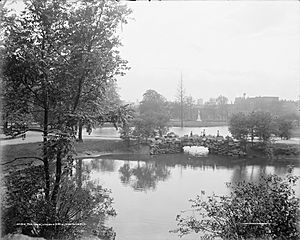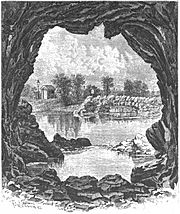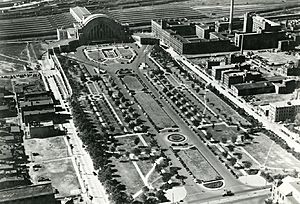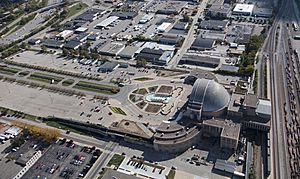Lincoln Park (Cincinnati) facts for kids
Quick facts for kids Lincoln Park |
|
|---|---|

Lincoln Park lake and statue, c. 1900-1910
|
|
| Type | City park |
| Location | Cincinnati, Ohio, U.S. |
| Area | 10–18 acres (4.0–7.3 ha) |
| Closed | 1929 |
| Designer | Adolph Strauch |
| Operated by | Cincinnati Park Board |
| Vegetation | 2,350 trees and shrubs 913 herbs |
Lincoln Park was a public park in the West End area of Cincinnati, Ohio. It is now part of the land around Cincinnati Union Terminal. The park featured a lake, an island, a gazebo, and green spaces with brick paths. It also had a baseball field.
Musicians often played music in the gazebo. In winter, the lake was a popular spot for ice skating. Lincoln Park was one of Cincinnati's first parks, created in 1858. It is one of the few early parks that no longer exists today. From 1929 to 1933, the park was redesigned. It became a beautiful green area for the entrance to Union Terminal. In 1980, much of the park's space was paved over. This was done to create a shopping mall called the Land of Oz at the terminal. Today, the Cincinnati Museum Center uses this area.
Contents
Where Was Lincoln Park Located?
Lincoln Park was located where the parking lot and entrance drive of Cincinnati Union Terminal are today. It was directly east of the terminal building. This area was first part of Cincinnati's Ward 16. Later, it became part of the West End neighborhood. Now, it is part of the Queensgate neighborhood. The park's borders were similar to the Union Terminal's land. Kenner Street was to the north, Hopkins Street to the south, Freeman Avenue to the east, and Hoefer Street to the west. Hoefer Street is now roughly where the rail yard behind the terminal is.
What Did Lincoln Park Look Like?
Over time, the park covered between 10 and 18 acres. It had a large public green space. There was also a man-made lake where people could go boating and fishing. The park included a sunken garden and a grotto, which is like a small cave. Kids could enjoy a playground and a wading pool. A small island in the lake had a decorative gazebo. Many park benches, brick walkways, and an outer fence completed the park.
Musicians often performed in the gazebo. Cincinnati residents would gather by the lake to listen to the music. The lake was home to swans and other special birds. From the park, you could see the Kentucky hills across the Mill Creek. When winter came, the lake often froze over, making it perfect for ice skating.
The park also had several shelter houses. A small building was built in 1892. In 1914, a larger shelter house was added. This was a two-story brick building. It had a big social room, changing rooms, and restrooms for men and women. It also included a tool room, a storage room, and other storage spaces.
History of Lincoln Park
The land for Lincoln Park was first bought by Cincinnati Township in 1829. In the 1830s, the township traded this land with the city of Cincinnati. Part of the land was used as a public burial ground for people who could not afford a private burial. It was also used for a building that cared for sick people. In 1857, neighbors complained, so the burial ground and the building for the sick were moved outside the city. The space was then turned into a park.
The park was first called West End Park. It was landscaped in June 1858, after the buried people were moved to another cemetery. Around 1865, the park was renamed Lincoln Park. This was done to honor President Abraham Lincoln, who had recently been assassinated.
In 1873, Adolph Strauch, a landscape architect for Cincinnati parks, improved the park. He added the small lake, a waterfall, and the island. He also created the grotto and brought in rare birds. Strauch planted new gardens and trees, making the park even more beautiful. These features were inspired by old English gardens.
In 1892, the park built a shelter house with a "refreshment room" and an office. In 1893, about 30,000 people visited the park each week from May to September. Even in other months, about 10,000 people visited weekly. In 1914, a new, larger shelter house was built. It was a two-story brick building with a big social room and other facilities.
When plans for the Union Terminal were made, Lincoln Park was in the way. Many other things like train tracks, a public dump, and houses also had to be moved or torn down. The terminal company planned to turn the park into a beautiful entrance drive for the terminal. They also agreed to create a new park called Laurel Park.
Lincoln Park was remodeled in 1932. Its lush plants, lake, and gazebo were removed. It became simpler, with just grass lawns and nice landscaping. This new design included elm and sycamore trees along the edges and flower beds in the middle. The terminal lawn, sometimes still called Lincoln Park, was about 1400 by 500 feet. It had wide driveways leading up to the terminal. The central landscaped strip is still there today. However, the areas to its north and south became parking lots in 1980. This was part of changes to open the terminal's shopping mall, the Land of Oz. The Cincinnati Museum Center now uses and maintains these parking lots.
In 1935, the road between the terminal and Cincinnati Music Hall was named Lincoln Park Drive. In 1976, this road was renamed Ezzard Park Drive. It was named after Ezzard Charles, a famous Cincinnati resident.
Statues in Lincoln Park
The park once had a statue of Captain John J. Desmond. It was placed on the south side of the lake and unveiled on May 6, 1899. Captain Desmond was a lawyer and a militia captain. He was killed during the Cincinnati riots of 1884. His statue was moved when Lincoln Park was redesigned for Union Terminal. It was first moved to Washington Park. Later, it found its final home in the lobby of the Hamilton County Courthouse. This courthouse is the building Desmond died defending. The large statue shows Desmond holding an American flag.
Lincoln Monument
In 1866, Thomas White designed a marble statue of Lincoln for the park. He offered it for free, hoping Cincinnati residents would help pay for his work. The monument was planned to be a 25-foot-tall temple. It would have Greek and Gothic designs, with decorated columns holding up a roof. A bust (head and shoulders statue) of Lincoln would be in the center. Adolph Strauch chose a spot by the lake so the monument would reflect in the water. The monument and bust were to be made of white Italian marble, with a base of granite. Two marble lions were planned for its base, and a sculpted bird on top. However, a disagreement arose about whether the monument was a donation. So, the marble company removed the monument during the night in 1872. The Lincoln bust later broke.
Baseball at Lincoln Park
The Lincoln Park Grounds, also known as Union Grounds, was a baseball field next to the park. It was removed to make space for Union Terminal's main building and plaza. The baseball park was built for the Union Cricket Club. The Cincinnati Base Ball Club also used it for a few seasons in 1860.




